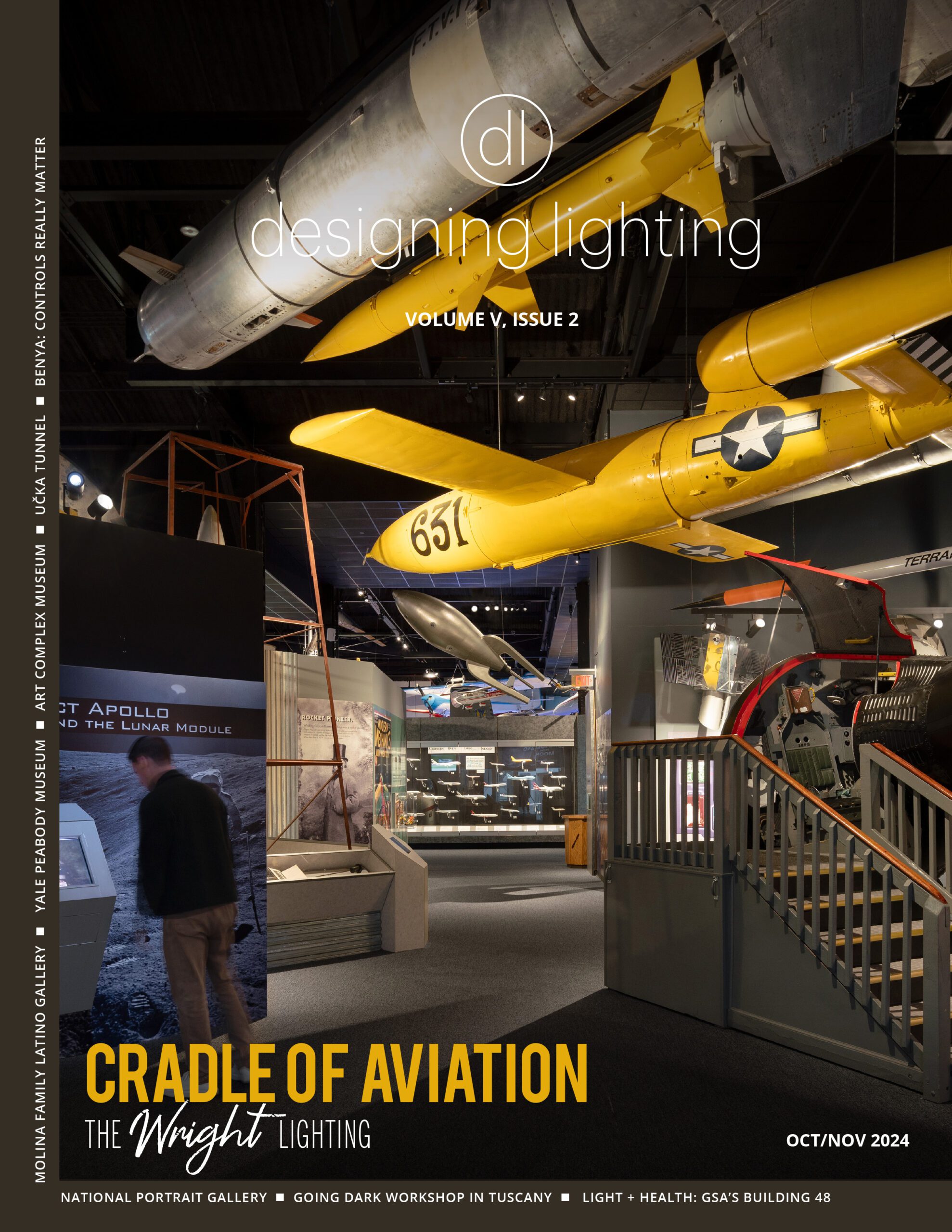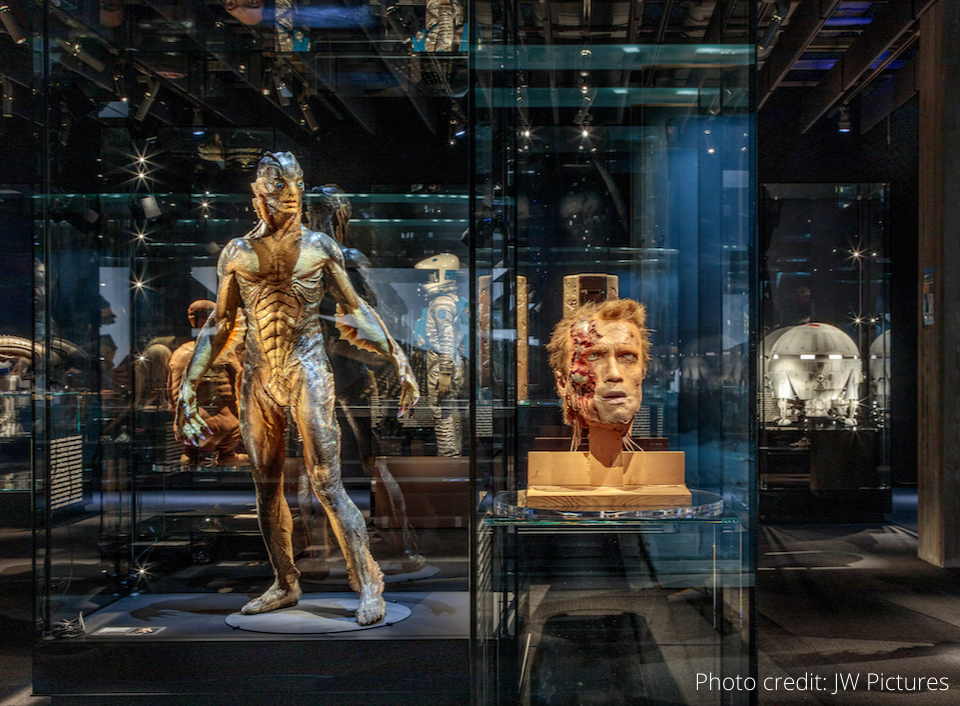Have you ever dreamed of meeting your favorite movie characters in person? You can do that now at the newly opened Academy Museum of Motion Pictures, located in Los Angeles, which contains over 50,000 square feet of exhibits and 822 artifacts, celebrating the art and science of movies of the past, present and future.
Lighting a museum to transcend a movie experience is difficult. In a theater, the audience views a movie totally in the dark with the light only from the screen. Since total darkness is not practical in a museum, how do you replicate the theater feel without the absence of light? Easy, you hire the team at Available Light.
Lead Designer Ted Mather, John Delfino, Alex Fabozzi, and colleague Dawn Hollingsworth accepted the challenge of lighting this one-of-a kind museum. I discussed this incredible project with Ted and John and later met Steven Rosen, President and Creative Director of Available Light, in Los Angeles for an in-person tour.
“A lot of the light is meant to be felt, and not specifically noticed” ―Steven Rosen
During our walk-thorough Steven explained the importance of light and color to give the museum that Academy feel. Due to significant artifact conservation requirements, the galleries have relatively low lumen levels; puddles of light aimed at the floor provide ambient circulation lighting while enhancing the Oscar’s celebratory theme. Blue curtains adorn the walls in many of the galleries, and those curtains are grazed with track lights from Lighting Services Inc outfitted with deep blue gels. The team specified 3000K for the artifacts and boosted that to 4000K for the circulation path which provides a visually exciting contrast. Orange gels are occasionally used in some areas to warm up the audience a bit. Steven explained, “A lot of the light is meant to be felt, and not specifically noticed.”
Academy Museum directors and curators participated in the lighting at a high level; the client managed every detail. The team spent a great deal of time in the construction administration phase, working closely with the client to fulfil their vision. Unlike typical lighting projects where designers spend most of their time off site, this trio spent close to 600 person-hours in the space thoughtfully crafting the lighting for each individual artifact. The stunning exhibits speak to this dedication and intentionality.
WHY Architects handled the exhibit design and Ted pointed out that curators needed a flexible space to be able to update and rotate content constantly. Similarly, John commented that they needed to specify lighting kits that were “extremely modular” so that they could be flexible and reconfigured on site as new temporary exhibits were added. In the Emmanuel Lubezki exhibition, one of the first temporary exhibits, there are six portraits lit with 3000K projectors with 4000K booster blue gels with a small hole cut in the center. The result is 3000K on the portrait faces and 4000K on the frames. Striking!
John said that some artifacts were reconfigured many times throughout the lighting design process until the story being told was just what the curators had in mind. Several curators were involved with lighting Dorothy’s famous ruby slippers in The Wizard of Oz. During the filming of the landmark movie, George Cukor, one of four directors, wanted the toes of the famous ruby slippers to almost glow red and the museum design did just that. Available Light used 3000K for the middle and back of the slippers with red LEDs aimed precisely on the toes and none of the red lumens slipped into the 80+ year old slippers.

Stories of Cinema Gallery, Academy Museum of Motion Pictures Photo by designing lighting
John discussed the light fixtures, lamps and controls that the team used for the project, remarking that when lighting a museum, they tend to have a very limited selection of fixtures they trust. The manufacturers that they knew would perform at the high level they require were Lighting Services, Inc, Soraa, and Luxam. John continued about how the track heads allowed for the customization of each exhibit, saying, “Almost every Lighting Services, Inc single track light and every Luxam spotlight has a built-in dimmer so we were able to sculpt with every fixture as an individual paintbrush.” Ted then highlighted the ETC control systems that they utilized throughout the project. The main system, Paradigm, is an architectural lighting processor that has user interface buttons to address macro-level switches. The second, Mosaic, was used for more specialized control, including pulsing and UV special effects.
“Things are meant to be seen naturally, with many different kinds of light hitting them at any given time.” ―Steven Rosen
The team was highly specific and detail oriented in their design, with the goal of bringing each individual artifact to life. In a display case where a typical design would use just two lights, Available Light may use 15 or more, each with a specific purpose. Rather than lighting each object evenly, the group utilized a theatrical lighting approach in a way that looked natural and dramatic. Ted also emphasized, “Things are meant to be seen naturally, with many different kinds of light hitting them at any given time.”
Ted described a constant tension between conservators and designers, who come from a more theatrical background. The job of the conservator is to safeguard the artifact for the ages by limiting the amount of light on any object. Each of these individual artifacts had extremely strict lighting requirements based on their age, material and fragility and many were limited to only 5 or less footcandles (50 lux). At that level, color acuity begins to wane and at 3 footcandles, objects can appear monochromatic. In addition, museums used to be lit in the 10 to 12 watts per square foot and today they are under 3. Title 24 did come into play and Steven said that museum exhibition lighting used to be exempt from energy codes but now the codes are catching up to the technology.
Available Light took advantage of color theory by manipulating color temperature and chroma in subliminal ways, with the intention of changing the way the audience perceived the objects. Steven added, “Direction and color are substituted for intensity.” John said that the techniques were meant to evoke internal feelings that some people may not even recognize which is a great definition of brilliant lighting. Ted continued, “Generate an emotional response if you really want people to tell their friends to come back, and maybe donate!”
One exhibit titled Imaginary Worlds, contains roughly 30 glass cases of all your favorites, from Star Wars’ C-3PO to our alien friend E.T. Steven described that 90% of the lighting was built into these cases using miniature 1.2 watt sources by Luxam mounted on vertically oriented tracks.

Photo by designing lighting
For example, the costume used in the movie The Shape of Water had ultraviolet-sensitive paint built into it to mimic bioluminescence on set. To highlight this effect and reveal these points of light throughout the extraordinary costume, the team strategically placed 32 luminaires, some of them ultraviolet, inside the glass case. The UV “blacklights” operate on a programmed dimming cycle so the luminescent patterns continually appear and disappear as visitors look into the case. The result is a remarkable display that closely resembles its appearance in the movie. When it comes to the number of luminaires lighting a display, Steven jokes that the Available Light motto has always been, “More is not enough.”
Objects weren’t the only things the team were tasked to light. Have you ever wondered how to light music? You borrow an idea from Stanley Kubrick.
The Gallery Talk exhibit features music from Hildur Guðnadóttir, who recently won a Grammy award for her score in the 2019 psychological thriller film Joker. Her plan for the gallery was a multichannel audio system where guests listen to music spatially without visual noise or distractions, but total darkness wasn’t practical or safe. She needed a visual hook for the eyes to land and enough light for people to enter and exit. Guðnadóttir took an unusual inspiration from the lens of Hal in 2001: A Space Odyssey. The design team created a crystal orb with an integral red LED that pulses at about the same rate as your breath. The music, combined with the pulsing red sphere is both multidimensional and mesmerizing as the pulsing red orb appears to float in midair. Add a halo of dim red light oozing out from beneath a circular platform/ bench and it is just enough light for people to move, but not enough to distract.

Photo by designing lighting
For the almost 30 foot tall painted backdrop from Hitchcock’s North by Northwest, Steven explained that this was the one area where uniformity was critical. Wide floods mounted closest to the backdrop illuminate the top of the drop, medium floods a distance further light the middle and narrow spots illuminate the bottom.

Credit: Backdrop: An Invisible Art, Hurd Gallery, Academy Mueseum of Motion Pictures Photo by Available Light
Other times, lighting was manipulated to resemble a particular scene in a film. For example, the exhibit featuring Cobblepot Manor from Batman Returns was lit with slightly cooler hues to recall a moonlit scene. The designers, with the permission of the conservator, took liberties in going a bit more theatrical with this display adjusting light to fade in some places and accentuate edges in others.
During our conversation, John made an interesting point about lighting a space for more than just the present viewer, but also for the camera. He said, “There is an ongoing relationship between an experience in a space, and the photo that will be taken with a phone and then shared on social media.” He continued, “The photo is what visitors will take home with them.” John commented that certain curators would judge the lighting design using their phone camera first. These realities forced the team to pivot and create a valuable experience while leaving visitors with a similarly valuable memento. You may see snapshots of these stunning exhibits on the Internet but the live experience, the magic of the design, is worth the in-person visit!

Black Panther Okoye Photo by designing lighting
Luminaires/Sources/Control:
Iguzzini: Hanging pendant cylinder for architectural houselights
Luxam: Mini-adjustable led track lights for in-case lighting
Lighting Services, Inc. (LSI): Gallery-wide track luminaires for floodlights and framing
Soraa: Retrofit PAR30 Lamps
Controls: ETC Paradigm, Mosaic
Color: 3000K with various gels for warming or cooling.
This article was originally featured in the October issue of designing lighting (dl).




